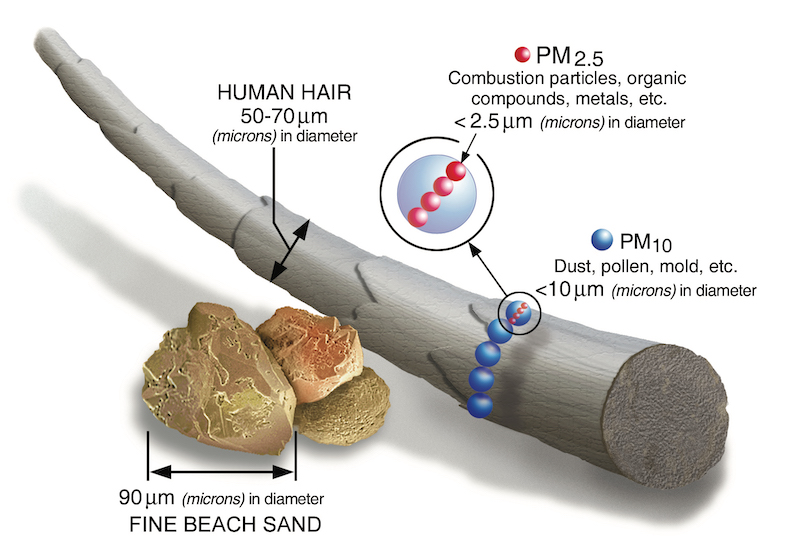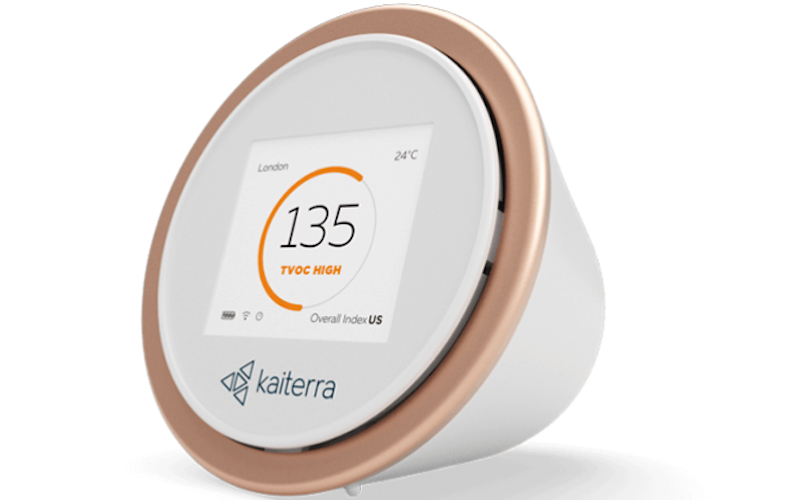After my article “How to Monitor Indoor Air Quality (IAQ) in Your Smart Home” was published by Residential Tech Today, I received a message from a reader informing me that I should take a look at the Kaiterra Sensedge IAQ monitor. At the writer’s suggestion I contacted Kaiterra and while they didn’t send me a Sensedge, they did send me one of their Laser Egg+ Chemical IAQ monitors to take a look at.
As the name implies, the Kaiterra Laser Egg+ Chemical includes sensors for both airborne particulates and chemicals. Both of these are very important indoor air pollutants.

As the above image illustrates, PM2.5 particles consist of, among other things, soot and tobacco smoke. Examples of PM10 particles are dust, pollen, and mold. Both PM10 and PM2.5 particles are especially dangerous to human health because they can get deep into the lungs and, in some cases, even get into the bloodstream. According to the U.S. Environmental Protection Agency (EPA), particulate pollution exposure has been linked to:
- Premature death in people with heart or lung disease
- Nonfatal heart attacks
- Irregular heartbeat
- Aggravated asthma
- Decreased lung function
- Increased respiratory symptoms, such as irritation of the airways, coughing or difficulty breathing.
The airborne chemical pollutants measured by the Laser Egg+ Chemical are volatile organic compounds (VOCs). Again, according to the EPA, VOCs are generated by:
- Paints, paint strippers, and other solvents
- Wood preservatives
- Aerosol sprays
- Cleansers and disinfectants
- Moth repellents and air fresheners
- Stored fuels and automotive products
- Hobby supplies
- Dry-cleaned clothing
- Pesticides
- Building materials and furnishings
- Office equipment such as copiers and printers, correction fluids, and carbonless copy paper
- Graphics and craft materials including glues and adhesives, permanent markers and photographic solutions.
Exposure to VOCs can typically result in irritation of the eyes, nose, and throat. Headaches and nausea are another common symptom of exposure. However, more serious health affects are damage to the liver, kidney, and central nervous system along with cancer.
Because of the serious health issues that can result from indoor air pollution, an IAQ monitor, such as the Kaiterra Laser Egg+ Chemical, is an important tool for making your home a safe and healthy place to live.
The Laser Egg+ Chemical IAQ Monitor differentiates itself from the competition through the use of a laser particle detector for measurement of particulates in the air. Most residential IAQ monitors use an infrared detector that is not as accurate as the sensor in the Laser Egg. There is a great article on the Kaiterra web site describing the different sensor technologies used for measuring particulates. You can find the article here.
Another difference between the Kaiterra Laser Egg+ Chemical and other IAQ monitors I have reviewed is that the Kaiterra Laser Egg+ Chemical doesn’t force you to use an app to view the readings it has collected. Instead the unit includes a 2.5-inch (measured diagonally) LCD display. Pressing the mode button on the top of the unit allows the user to cycle through the various display screens including:
- Overall indoor Air Quality Index (AQI) based on a combination of the PM2.5 and Total VOC (TVOC) readings.
- Indoor AQI that displays a reading from 0 to 500 based on PM2.5 level
- PM2.5 concentration used to calculate the air quality index measured in micrograms per cubic meter (µg/m3)
- TVOC index that displays a reading from zero to 100 based on the TVOC level
- Relative TVOC concentration in parts per million (ppm)
- Details screen displaying >0.3 particle count, current temperature, and current humidity
- Local weather forecast
- A screen that will shut off the LCD back light so the unit can be placed in a bedroom and not disrupt someone trying to sleep
Connecting the device to the Kaiterra app does offer some advantages because it is through the app that the unit is connected to the homeowner’s Wi-Fi network. These advantages are:
- Display of the weather forecast
- Pollution alerts sent as app notifications
- Automatic calibration
- Firmware updates
Another convenience is that the app also offers the ability for the user to select which screens are displayed when the mode button is pressed. So, for example, if you don’t care about the temperature and humidity data that is displayed on the “details” screen, that screen can be turned off to minimize the number of times the mode button needs to be pressed to cycle through all the screens displaying data.
Setup
Setup is very simple. After plugging the device in and pressing the mode button several times it starts providing limited IAQ readings, as described above. The next step is to connect the Laser Egg+ Chemical to the Kaiterra App.
After the app is downloaded from the appropriate app store, simply press the “Add” button displayed on the screen. After selecting the type of device you are adding, the device can simply be added through the capture of a HomeKit setup image. The room where the device will be located and the location of your home are then selected. It should be noted that it can take a few minutes for these selections to take affect after you have made them. There is an on-screen note that informing the person setting up the device of this; but it is easy to miss.
Finally, you can select the brightness of the display, the temperature format (Celsius or Fahrenheit), language (English or Chinese), the screens you want to appear when you press the mode button on the device, and the size that information will be displayed (zoom mode on/off).
It should be noted that while the Laser Egg+ Chemical currently only supports English and Chinese, the app supports English, Chinese, German, Polish, Spanish, French, and Hindi.
Integration
The Kaiterra Laser Egg+ Chemical offers a wealth of ways to integrate the device into a smart home. Like most other IAQ monitors the device can be integrated with a smart home through IFTTT. Applets can be created that are triggered based on readings from the connected device, hourly averages of readings from the device, data from the device above a threshold, AQI by location, and AQI by location and above a threshold.
Unlike any other of the IAQ monitors that I have worked with, Kaiterra is the only one to include HomeKit integration. This is a welcome bonus for people whose smart homes are based around Apple products and their HomeKit standard.
Finally, the Kaiterra has published an API that can be used by smart home system manufacturers to integrate Kaiterra IAQ monitors with their platforms. The API is public and can even be used by hobbyists. I have used the API and developed a module to integrate the Kaiterra Laser Egg+ Chemical monitor with a Crestron based smart home system. The module is available for download from my GitHub here.
Suggestions for Improvement
While the Kaiterra Laser Egg+ Chemical includes a more accurate PM2.5 sensor compared to competitors and offers more integration choices it isn’t without areas where I believe the product could be improved.
- The app and the display on the device augment each other vs. providing some redundant views of the data. For example, the app displays the outdoor air quality from the local monitoring station but this data isn’t available on the device. Another example is that the data for the primary pollutant (either TVOC or PM2.5) is available through the app but you can’t see the other data readings accept in the form of historical graphs. While it makes sense that the App will display graphs that aren’t available on the device’s small display, all the basic IAQ data from the device should be available in the app. You shouldn’t have to walk to the location of the device in your home just to view this data.
- The two physical buttons (power and mode) on the unit itself are small. Larger buttons would be easier to use.
- The unit makes a perceptible humming noise from a fan that helps to circulate air though it for measurements. The noise is loud enough that it might disturb someone trying to sleep if the unit were placed on a night stand. A quieter fan would be a nice improvement
- Unlike any other IoT device I’ve worked with the Kaiterra Laser Egg+ Chemical doesn’t come with a power supply. It does include a power cable but the purchaser is expected to supply their own USB power supply. Kaiterra has informed me that they are addressing this issue and units will be shipping with power supplies in the near future.
- No CO2 sensor. CO2 is a common indoor air pollutant. It builds up in a home as people breath when there isn’t adequate ventilation. Symptoms include drowsiness and headaches. On 9/24/19 Kaiterra released a Laser Egg+ CO2 IAQ monitor. Kaiterra sent me one to evaluate right before the publication of this article. While I didn’t have time to include details about the LaserEgg+ CO2 in this article, I was able to update the Crestron module on my GitHub so that it will work with both the LaserEgg+ Chemical and the LaserEgg+ CO2. That being said, I would like to see a single, comprehensive monitor that covers particulates, VOCs, and CO2 rather than requiring a consumer to purchase two devices to get a comprehensive view of their indoor air quality.
- The Kaiterra Laser Egg+ Chemical includes HomeKit integration, IFTTT integration, and a published API. Unfortunately, it doesn’t include integration with either Alexa or Google Assistant. Given how large a market share are held by these two voice assistant platforms, Kaiterra should include integration with at least one, if not both, of them.
Summary
Overall the Kaiterra Laser Egg+ Chemical is an excellent product. The inclusion of a laser particle counter for measuring particulate pollution along with a choice of integration options sets it apart from the competition. The only true miss in the device’s design is the lack of a sensor to measure CO2; a common indoor air pollutant. Finally, the app should be improved to provide display of all the data captured by the device.








